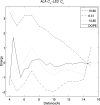A position-specific distance-dependent statistical potential for protein structure and functional study
- PMID: 22608968
- PMCID: PMC3372698
- DOI: 10.1016/j.str.2012.04.003
A position-specific distance-dependent statistical potential for protein structure and functional study
Abstract
Although studied extensively, designing highly accurate protein energy potential is still challenging. A lot of knowledge-based statistical potentials are derived from the inverse of the Boltzmann law and consist of two major components: observed atomic interacting probability and reference state. These potentials mainly distinguish themselves in the reference state and use a similar simple counting method to estimate the observed probability, which is usually assumed to correlate with only atom types. This article takes a rather different view on the observed probability and parameterizes it by the protein sequence profile context of the atoms and the radius of the gyration, in addition to atom types. Experiments confirm that our position-specific statistical potential outperforms currently the popular ones in several decoy discrimination tests. Our results imply that, in addition to reference state, the observed probability also makes energy potentials different and evolutionary information greatly boost performance of energy potentials.
Copyright © 2012 Elsevier Ltd. All rights reserved.
Figures



Similar articles
-
Improving the orientation-dependent statistical potential using a reference state.Proteins. 2014 Oct;82(10):2383-93. doi: 10.1002/prot.24600. Epub 2014 Jun 3. Proteins. 2014. PMID: 24810843
-
Random Forest Refinement of the KECSA2 Knowledge-Based Scoring Function for Protein Decoy Detection.J Chem Inf Model. 2019 May 28;59(5):1919-1929. doi: 10.1021/acs.jcim.8b00734. Epub 2019 Feb 20. J Chem Inf Model. 2019. PMID: 30726079
-
Novel knowledge-based mean force potential at the profile level.BMC Bioinformatics. 2006 Jun 27;7:324. doi: 10.1186/1471-2105-7-324. BMC Bioinformatics. 2006. PMID: 16803615 Free PMC article.
-
Statistical mechanics-based method to extract atomic distance-dependent potentials from protein structures.Proteins. 2011 Sep;79(9):2648-61. doi: 10.1002/prot.23086. Epub 2011 Jul 5. Proteins. 2011. PMID: 21732421 Free PMC article.
-
Boltzmann-like statistics of protein architectures. Origins and consequences.Subcell Biochem. 1995;24:1-26. doi: 10.1007/978-1-4899-1727-0_1. Subcell Biochem. 1995. PMID: 7900172 Review. No abstract available.
Cited by
-
Deep template-based protein structure prediction.PLoS Comput Biol. 2021 May 3;17(5):e1008954. doi: 10.1371/journal.pcbi.1008954. eCollection 2021 May. PLoS Comput Biol. 2021. PMID: 33939695 Free PMC article.
-
Optimized atomic statistical potentials: assessment of protein interfaces and loops.Bioinformatics. 2013 Dec 15;29(24):3158-66. doi: 10.1093/bioinformatics/btt560. Epub 2013 Sep 27. Bioinformatics. 2013. PMID: 24078704 Free PMC article.
-
Representations of protein structure for exploring the conformational space: A speed-accuracy trade-off.Comput Struct Biotechnol J. 2021 Apr 28;19:2618-2625. doi: 10.1016/j.csbj.2021.04.049. eCollection 2021. Comput Struct Biotechnol J. 2021. PMID: 34025948 Free PMC article.
-
A tale of solving two computational challenges in protein science: neoantigen prediction and protein structure prediction.Brief Bioinform. 2022 Jan 17;23(1):bbab493. doi: 10.1093/bib/bbab493. Brief Bioinform. 2022. PMID: 34891158 Free PMC article. Review.
-
Reconstructing protein structures by neural network pairwise interaction fields and iterative decoy set construction.Biomolecules. 2014 Feb 10;4(1):160-80. doi: 10.3390/biom4010160. Biomolecules. 2014. PMID: 24970210 Free PMC article.
References
-
- Bauer A, Beyer A. An Improved Pair Potential to Recognize Native Protein Folds. Proteins-Structure. Function and Genetics. 1994;18:254–261. - PubMed
-
- Bradley P, Malmstrom L, Qian B, Schonbrun J, Chivian D, Kim DE, Meiler K, Misura KMS, Baker D. Free modeling with Rosetta in CASP6. Proteins. 2005;61:128–134. - PubMed
-
- Bryngelson JD, Onuchic JN, Socci ND, Wolynes PG. Funnels, Pathways, and the Energy Landscape of Protein-Folding - a Synthesis. Proteins-Structure Function and Genetics. 1995;21:167–195. - PubMed
-
- Bystroff C, Thorsson V, Baker D. HMMSTR: a hidden Markov model for local sequence-structure correlations in proteins. J Mol Biol. 2000;301:173–190. - PubMed
Publication types
MeSH terms
Substances
Grants and funding
LinkOut - more resources
Full Text Sources
Other Literature Sources
Molecular Biology Databases

